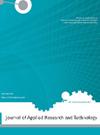基于六自由度UDF和滑动网格法的水轮机性能仿真
Q3 Engineering
Journal of Applied Research and Technology
Pub Date : 2023-04-27
DOI:10.22201/icat.24486736e.2023.21.2.1568
引用次数: 0
摘要
本文利用ANSYs Fluent软件对阿基米德螺杆式水轮机的六自由度(6-DoF)方法和滑动网格方法进行了流体动力学仿真比较。在文献实验数据的基础上,比较了功率系数()值与叶顶速比()的数值曲线。因此,将该数值作为数值与实验数据的比较基准参数,采用六自由度法和滑动网格法得到的误差分别为13%和40%。两种方法都可以模拟转子的旋转,虽然6自由度方法在涡轮性能预测上更准确,但与滑动网格方法相比,消耗的计算资源更高,可以在负担得起的时间内获得计算解。本文章由计算机程序翻译,如有差异,请以英文原文为准。
Performance simulation of water turbines by using 6-DoF UDF and sliding mesh methods
In this work, a comparison between the six degrees of freedom (6-DoF) method and the sliding mesh approach in computational fluid dynamics simulations of an Archimedes screw turbine for hydrokinetic applications was performed using ANSYs Fluent software. The numerical curves obtained by representing the power coefficient () values versus the tip speed ratio ( or ) were compared based on the experimental data available in the literature. Therefore, by considering the values as the comparison benchmark parameter between the numerical and experimental data, the error obtained when using the 6-DoF method and the sliding mesh approach was 13% and 40%, respectively. Both methods allowed the simulation of the rotor rotation, although the 6-DoF method was more accurate in the prediction of the turbine performance, higher computational resources were consumed in comparison with the sliding mesh method, which allows to obtain a computational solution in affordable times.
求助全文
通过发布文献求助,成功后即可免费获取论文全文。
去求助
来源期刊

Journal of Applied Research and Technology
工程技术-工程:电子与电气
CiteScore
1.50
自引率
0.00%
发文量
0
审稿时长
6-12 weeks
期刊介绍:
The Journal of Applied Research and Technology (JART) is a bimonthly open access journal that publishes papers on innovative applications, development of new technologies and efficient solutions in engineering, computing and scientific research. JART publishes manuscripts describing original research, with significant results based on experimental, theoretical and numerical work.
The journal does not charge for submission, processing, publication of manuscripts or for color reproduction of photographs.
JART classifies research into the following main fields:
-Material Science:
Biomaterials, carbon, ceramics, composite, metals, polymers, thin films, functional materials and semiconductors.
-Computer Science:
Computer graphics and visualization, programming, human-computer interaction, neural networks, image processing and software engineering.
-Industrial Engineering:
Operations research, systems engineering, management science, complex systems and cybernetics applications and information technologies
-Electronic Engineering:
Solid-state physics, radio engineering, telecommunications, control systems, signal processing, power electronics, electronic devices and circuits and automation.
-Instrumentation engineering and science:
Measurement devices (pressure, temperature, flow, voltage, frequency etc.), precision engineering, medical devices, instrumentation for education (devices and software), sensor technology, mechatronics and robotics.
 求助内容:
求助内容: 应助结果提醒方式:
应助结果提醒方式:


